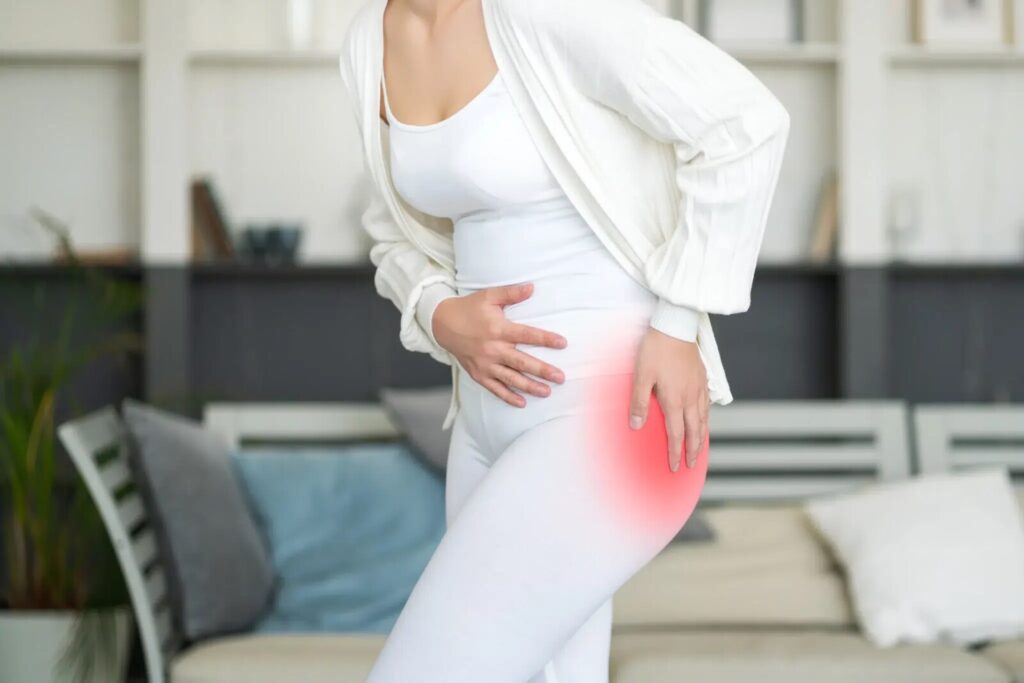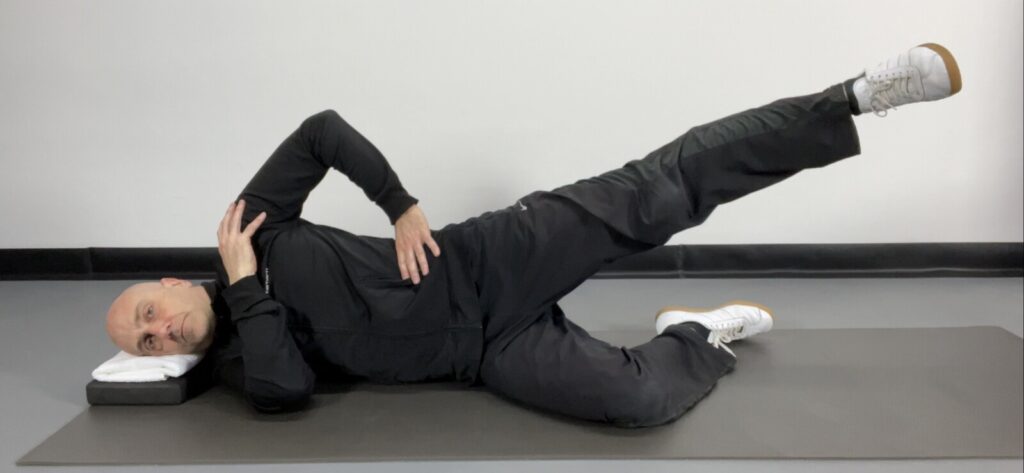In this post we discuss lateral hip pain and the best exercises for relief and recovery.

At a glance
Lateral hip pain (GTPS) is commonly caused by irritation of the gluteus medius and gluteus minimus tendons.
It affects both sedentary and active people, especially middle-aged women and runners.
Tendon overload or underuse disrupts function, leading to pain and weakness.
Research strongly supports progressive resistance exercise over rest or corticosteroid injections.
Hip abduction exercises, using both static and dynamic movements, are effective.
Begin with low load, monitor response, and progress gradually if symptoms don’t worsen after 24 hours.
What is lateral hip pain?
Lateral hip pain, or greater trochanteric pain syndrome (GTPS) as it’s now called, is pain that’s localised to an area just above the greater trochanter (the bone that sticks out at the side of your hip).
In some cases people will also experience soreness down the outside of their leg and up into the buttock.
It’s more common among middle-aged people, with women being more susceptible than men. It can affect both the sedentary and the active alike, with distance runners being particularly prone to the condition.
Sufferers will feel a point of exquisite tenderness if the area just above the greater trochanter is pressed. They’ll also feel pain when asked to stand on the affected leg for longer than 30 seconds.
What causes greater trochanteric pain syndrome (GTPS)?
If you’ve been diagnosed with GTPS then the most likely source of pain is the tendon of one or more of the hip abductor muscles. Usually gluteus medius or gluteus minimus. In some cases the greater trochanteric bursa is also involved.
The hip abductor muscles provide lateral support to the pelvis. This is particularly important in activities which require you to land on a single leg, like running and jumping.
The precise cause can be difficult to pin down, although a rapid increase in activity may be responsible in some cases. In others, it’s likely that structural differences like the width of the pelvis play a role. This may explain why women are more susceptible than men.
Ultimately, it’s probably a combination of factors that leads to disruption of the tendons.
What is the best treatment for GTPS?
Essentially GTPS is a tendon issue in the majority of cases. Tendons are the structures that attach muscles to bone. Like muscles they require force to remain healthy.
When a muscle has been either overloaded, or under used, its ability to generate force is compromised. If this situation is allowed to persist, the tendon becomes affected.
Most tendon issues are now described as tendinopathies. This is because inflammation isn’t considered to be the primary issue. A more accurate picture is one of disorganisation.
So in order to improve the tendon’s health, you need to stimulate a reorganisation. How do you do that? By placing just the right amount of force through it.
Research on gluteal tendinopathy
Whilst the majority of tendon research has been carried out on the Achilles tendon, there are some studies on gluteal tendon issues.
This review compared the effect of exercise to both ‘wait and see’ and corticosteroid injections. They found progressive loading of the tendon to be superior to both rest and corticosteroids, in both short and long term function.
Exercise also demonstrated a higher success rate both in the short and long term for pain reduction, when compared to corticosteroid injections.
This recently published review looked at 6 trials which included 733 patients overall. They found a strong recommendation for exercise as a first line treatment in patients diagnosed with GTPS. Again, exercise was found to be superior to corticosteroid injections.
Interestingly, none of the included trials featured exercises specific to the involved tendon, and all used home exercise programmes. Whilst this approach is easier to scale by health providers, it might not be the ideal way to rehabilitate tendons.
This review looked more closely at the most effective dose of resistance training to rehabilitate tendons. They included studies on gluteal tendons, as well as those on shoulder, elbow, ankle, and knee tendons.
The authors found evidence that higher loads using resistance training equipment and not just body weight, produced superior results. This combined with longer rest periods between sessions, promoted faster adaptation in the tendon.
What is the best exercise for gluteal tendinopathy?
Whilst we are still some way from a gold standard exercise for treating gluteal tendinopathy, it seems we have some clues as to the direction to take.
We know the role of both gluteus medius and gluteus minimus is to move the leg out to the side. This is called hip abduction.
If you wish to target these muscles and their tendons, this is the direction you should move the affected leg.
The key is to find a starting point that doesn’t create a significant flare in your symptoms for longer than 24 hours after the exercise. Some soreness immediately afterwards isn’t a cause for concern.
Research has shown that progress can be made using both isometric and isotonic muscle contractions of the hip abductor muscles. In other words, both static holds and movement, works to improve gluteal tendon issues.
The study above used holds in the position below, as well as movement into and out of this position.

Summary
Lateral hip pain, or GTPS, is caused by the tendons of gluteus medius or gluteal minimus in most cases.
Strengthening exercises directed both at the hip abductors, and more generally at the muscles of the lower body, have been shown to be effective. More so than either corticosteroid injections or shockwave therapy.
Start easy and monitor your symptoms. As long as you’re not experiencing an increase in pain for longer then 24 hours after exercise, you’re on the right track.